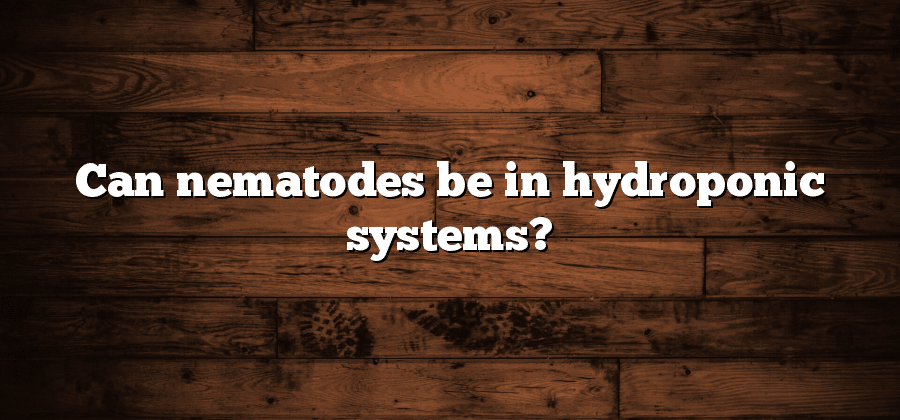Nematodes and Hydroponics: A Compatibility Study
Nematodes are microscopic, worm-like organisms that can have both beneficial and detrimental effects on hydroponic systems. However, their compatibility with hydroponics largely depends on the specific species of nematode and the management practices in place.
Some species of nematodes, such as Steinernema feltiae and Heterorhabditis bacteriophora, can actually be beneficial in hydroponic systems. These nematodes are known as entomopathogenic nematodes, meaning they parasitize and kill insects that may otherwise pose a threat to the hydroponic crops. By using these nematodes as a biological control method, hydroponic growers can reduce the need for chemical pesticides and, ultimately, improve the overall health and productivity of their crops.
On the other hand, certain species of nematodes can be problematic in hydroponic setups. These include plant-parasitic nematodes such as Meloidogyne spp., which feed on the roots of plants and can cause stunted growth and yield losses. It is important for hydroponic growers to be able to identify and manage these harmful nematodes to prevent significant damage to their crops.
Understanding the compatibility of nematodes and hydroponics is essential for successful hydroponic cultivation. By recognizing the potential benefits and challenges associated with nematodes in hydroponic systems, growers can adopt appropriate prevention and management strategies, ensuring optimal plant health and productivity.
Understanding Nematodes in Hydroponic Environments
Nematodes, small roundworms commonly found in soil and water, can pose a significant challenge in hydroponic environments. These microscopic creatures thrive in moist conditions, making hydroponic systems an ideal habitat for their growth and reproduction. As a result, understanding nematodes and their impact on hydroponic systems is crucial for maintaining plant health and productivity.
One of the main concerns with nematodes in hydroponics is the potential damage they can cause to plant roots. Nematodes feed on the roots of plants, leading to reduced nutrient uptake and stunted growth. In severe cases, nematode infestations can even result in the death of plants. This makes it essential to identify and address nematode presence as early as possible to prevent further damage.
In order to effectively manage nematode populations in hydroponic systems, growers must adopt preventive strategies and integrated pest management techniques. This may include regular monitoring of plants and roots for signs of nematode activity, implementing proper sanitation practices, and using biological controls such as beneficial nematodes or predatory mites. By understanding the behaviors and lifecycles of nematodes, hydroponic growers can take proactive steps to minimize the impact of these microscopic pests and maintain a healthy and thriving cultivation environment.
The Impact of Nematodes on Hydroponic System Health
Nematodes are microscopic worms that can have a significant impact on the health of hydroponic systems. These pests are especially problematic in hydroponics because they can quickly reproduce and spread throughout the system, causing damage to the roots of plants. This can lead to reduced nutrient uptake, stunted growth, and ultimately, decreased crop yields.
One of the main consequences of nematode infestation in hydroponic systems is the disruption of the balance between the plant and the nutrient solution. Nematodes feed on plant roots, causing damage that can compromise their ability to absorb the necessary nutrients for growth. As a result, plants may become weak and more susceptible to nutrient deficiencies, disease, and other environmental stresses. Additionally, the presence of nematodes can lead to a decline in water and nutrient uptake efficiency, further exacerbating the negative effects on plant health.
Identifying Nematodes in Hydroponic Setups
Identifying nematodes in hydroponic setups can be a challenging task due to their microscopic size and elusive nature. However, it is crucial to detect their presence early on to prevent potential damage to the hydroponic system. A careful examination of the plant roots is a good starting point. Infested roots may exhibit stunted growth, discoloration, lesions, or even deformities. Additionally, the presence of galls or knots on the roots can also indicate nematode infestation.
Another method to identify nematodes in hydroponic setups is through soil or substrate sampling. Carefully collect samples from different parts of the system, including the growing medium, reservoir, and any filters or screens. Once obtained, these samples can be examined under a microscope to look for the presence of nematodes. It is important to remember that nematode identification requires specialized knowledge and training. Therefore, if any nematodes are found, it is recommended to consult with a local agricultural extension service or nematology expert for accurate identification and appropriate management strategies.
Nematode Prevention Strategies for Hydroponic Systems
Nematodes, microscopic roundworms that can wreak havoc on plant roots, pose a significant threat to hydroponic systems. In order to maintain the health and productivity of these systems, it is crucial to implement effective nematode prevention strategies. The first step in preventing nematode infestation is to start with clean, disease-free plants. Proper sanitation practices, such as sterilizing tools and equipment, can also help prevent the introduction of nematodes into the system.
Another important strategy is to maintain optimal growing conditions. Nematodes thrive in moist environments, so it is essential to regulate the moisture levels in the hydroponic system. Implementing proper drainage and ensuring adequate air circulation can help create an environment that is less favorable for nematode reproduction and survival. Additionally, monitoring and maintaining nutrient levels is crucial, as nutrient imbalances can weaken plants and make them more susceptible to nematode attacks.






